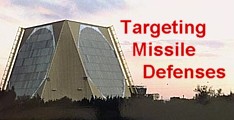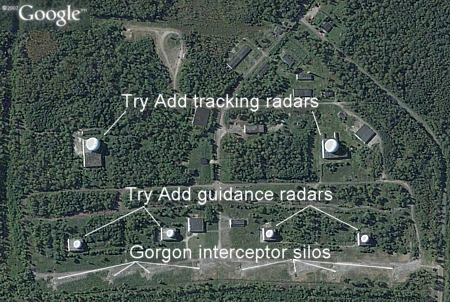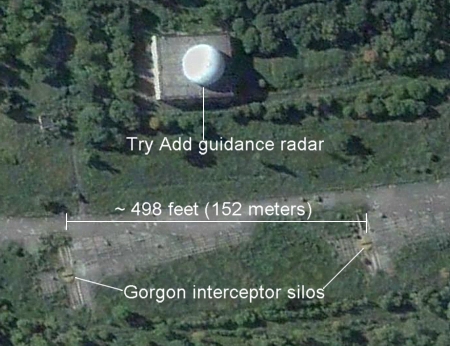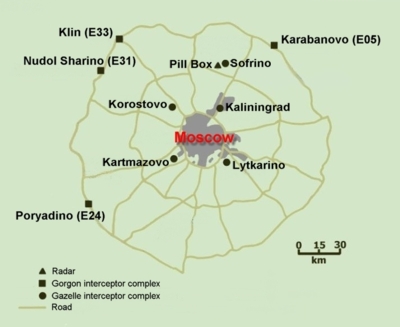
By Hans M. Kristensen
The now month-long clash between Russia and the West over U.S. plans to build a missile defense system in Europe should warn us that – despite important progress in some areas – Cold War thinking is alive and well.
The missile defense system, Moscow says, is but the latest step in a gradual military encroachment on Russian borders by NATO, and could well be used to shoot down Russian ballistic missiles. The head of Russia’s Strategic Missile Forces and President Putin have suggested that Russia might target the defenses with nuclear weapons. The United States has rejected the complaints insisting that Russia has nothing to fear and that the defenses will only be used against Iranian ballistic missiles. European allies have complained that the Russian threats are unacceptable and have no place in today’s Europe.
That may be true, but the reactions have revealed a frightening degree of naiveté about strategic war planning in the post-Cold War era, a widespread belief that such planning has somehow stopped. It has certainly changed, but all the major nuclear weapon states insist that they must hedge against an uncertain future and continue to adjust their strike plans against potential adversaries that have weapons of mass destruction. Russia continues to plan against the West and the West continues to plan against Russia. The plans are not the same that existed during the Cold War, but they are strike plans nonetheless.
The argument made by some officials that missile defense systems are merely defensive and don’t threaten anyone is disingenuous because it glosses over a fact that all planners know very well: Even limited missile defenses become priority targets if they can disturb other important strike plans. The West concluded that very early on in its military relationship with Russia.
Cold War Targeting of Missile Defense Systems
In 2003, I received a declassified Strategic Air Command document that showed how the United States reacted when the Soviet Union built a limited missile defense system back in the late 1960s. The response was overwhelming: A nuclear strike plan that included more than 100 ICBMs plus an unknown number of SLBMs to overwhelm and destroy the Soviet interceptors and radars. Based on the declassified information, two colleagues and I estimated in an article in the Bulletin of the Atomic Scientists that the total strike plan involved approximately 130 nuclear warheads with a total combined yield of some 115 megatons. Here is how the SAC historian described the plan:
|
|
 |
|
“To ensure the penetration of the ICBM force, the Soviet ABM system would be attacked first. Minuteman E and F and Polaris missiles would first hit the Hen House early warning radars, and their Tallin system defenses [SA-5 SAM, ed.]. Then the Dog House radar and the Triad system around Moscow would be attacked. More than 100 Minuteman would be involved in the ABM suppression.” |
The Soviet ABM system back then consisted of about fifteen facilities, including eight launch sites around Moscow with a total of 64 nuclear-tipped interceptors, half a dozen SA-5 launch complexes (later found not to have much ABM capability) near Leningrad (now St. Petersburg), and at least three large early warning radars. Each of these surface facilities were highly vulnerable to the blast effect from a single nuclear warhead, so the large number of ICBMs was mainly needed to “suppress” (overwhelm) the interceptors.
In the late 1980s, the Soviets upgraded they system by moving 32 remaining interceptors at four sites into underground silos (see Figure 2) and adding 68 shorter-range nuclear-tipped interceptors at five new sites closer to Moscow. This hardened and dispersed the interceptors, requiring U.S. planners to upgrade their strike plan, which probably ballooned to more than 200 warheads (although with less total yield due to more accurate missiles with less powerful warheads).
|
|
  |
|
Four long-range Gorgon interceptor site crescent Moscow toward the northwest. The 217-mile (350-kilometer) range Gorgon carries a 1 Megaton warhead. The site shown here is near Poryadino southwest of Moscow. There are unconfirmed rumors that the interceptors have been removed and the system is in the process of decommissioning. |
The 68 shorter-range (50 miles, 80 km) interceptors added to the system in the late 1980s were the nuclear-armed Gazelle. Each missile carried a 10-kiloton warhead. The five launch sites, which are still thought to be operational, are positioned in a circle around Moscow approximately 13 miles (23 kilometers) from the center of the city. The 68 interceptors are deployed in hardened silos, 16 at two sites (Northwest and Southeast), and 12 at each of the other three sites. Public uncertainty about the location of the fifth site was recently resolved by a satellite image showing the site next to the Pill Box radar north of Moscow.
|
|
  |
|
Five launch sites with Gazelle interceptors in hardened silos are located in a circle around Moscow as part of the A-135 ABM system. The sites have either 12 silos, like the Southwestern site (top) near Moscow Vnukovo airport, or 16. The fifth site (bottom) next to the Pill Box ABM radar north of Moscow has 12 silos, and is depicted in the Pentagon drawing (insert). |
All of this happened during the Cold War and many things have changed, but the basic motivation for targeting a limited missile defense system then was the same as today: The Soviet ABM system was entirely defensive and couldn’t threaten anyone (to paraphrase a characterization frequently use by U.S. and NATO officials to justify their missile defense plans today), but it could disturb the main ICBM attack on Moscow and military facilities downrange. That made it a top-priority target. And even though U.S. planners suspected that the system was not very efficient, they committed about 10 percent of the entire ICBM force to destroy it. To the extent the Russia ABM is operational, U.S. nuclear strike plans probably still target it today.
|
Figure 4: |
||
 |
||
| Type | Designation, Location | Remarks |
| Interceptor | ||
| Gorgon (SH-11/ABM-4)* | – E05, 6 miles (9 km) southwest of Karabanovo, at 56°14’39.51″N, 38°34’41.75″E | |
| – E24, 4 miles (6.5 km) northwest of Poryadino, at 55°20’58.31″N, 36°28’50.28″E | ||
| – E31, 6 miles (9.6 km) north of Nudol Sharino, at 56° 9’0.18″N, 36°30’13.08″E | Operational status uncertain | |
| – E33, east of Klin, at 56°20’30.03″N, 36°47’35.21″E | Operational status uncertain | |
| Gazelle (SH-08/ABM-3) | – South of Ashcherino, at 55°34’40.06″N, 37°46’17.89″E | |
| – 3 miles (4.8 km) southeast of Kaliningrad, at 55°52’41.63″N, 37°53’37.51″E | ||
| – 1 mile (1.6 km) north of Kartmazovo, at 55°37’31.81″N, 37°23’19.99″E | ||
| – Korostovo, at 55°54’6.00″N, 37°18’28.33″E | ||
| – 6 miles (9.6 km) west of Sofrino, at 56°10’50.69″N, 37°47’12.01″E | ||
| Radar** | ||
| Pill Box (Don-2N) | – 7 miles (11.3 km) west of Sofrino, at 56°10’23.48″N, 37°46’12.51″E | |
| To view satellite images of all these sites, click here. * There are unconfirmed rumors that the Gorgon interceptors have been removed from the system. ** Other forward-based early-warning radars are not included in this overview. Two older radars (Dog House and Cat House) are no longer operational. |
||
Now history repeats itself, but the table has been turned. Today it is the United States building a limited missile defense system (more capable than the Soviet system, but focused on “rogue” state missiles), and it is the Russians who say they need to target it to maintain the effectiveness of their deterrent. The Cold War may be over, but military and policy planners in both countries still think in Cold War terms.
Russia’s Real Concerns Today
Most of the current debate has focused on whether the missile defense system could disrupt Russia’s deterrent against the United States. Although this may be a concern to Russian planners in the long run, their objections probably have more to do with the capability of the system to disrupt limited strikes against France or the United Kingdom. Russian nuclear strike plans against each of those smaller nuclear powers probably include only a few ICBMs, but their flight path would take them right over the planned interceptors (Figure 5).
|
Figure 5: |
 |
|
The Russian objections to the proposed US anti-ballistic missile defense system in Poland and the Czech Republic seem more linked to potential Russian strike plans against British and French nuclear forces than to strike plans against the United States. The trajectories for a hypothetical ICBM attack against French and British nuclear submarines bases pass over the proposed U.S. missile defense system in Europe. |
Russian planners are probably also thinking ahead. By 2015, under current plans, Russia’s ICBM force is expected to have declined from about 480 missiles today to approximately 150. Significantly less than the 450 the United States plans to retain. This, of course, will have no real implications for Russia’s security, but for Russian planners it means that a European ballistic missile defense system with 10 interceptors (that could quickly be expanded) and 21 interceptors at Fort Greely in Alaska (and silos already dug for more) suddenly doesn’t seem so limited anymore. Indeed, if Russia’s statements about targeting a future missile defense system in Europe are genuine, then the U.S. interceptors in Alaska are probably already targeted by Russian missiles.
Implications
There’s probably a fair amount of chest beating in the Russian statements, especially because Russia has little to gain from antagonistic relations with the West in the long run. Putin’s recent “offer” to include Russian radars in the Western defense plans suggests he is trying to find a way out of the stalemate, although not necessarily the way out that Western governments would like to see.
It would, of course, be much simpler if the Russians “just got over it” and accepted Western missile defenses as a fact of life. But they haven’t, and there are clear signs that U.S. missile defense plans have already influenced Russian military planning. An eerie feeling is emerging in Washington that the Russian “experiment” may be over and that Russia, instead of becoming a full partner or a full enemy, is entering a new assertive period intent on acting as a counterbalance to current U.S. foreign policy. That may not necessarily be a bad thing, unless of course it plays out in the form of military posturing.
Western claims that Russia has nothing to fear, although genuine, miss the point: They apparently fear something enough to publicly use it to underscore their own capability. East and West need to figure out what has gone wrong and how to get out of this mess before strategic antagonism becomes a prominent policy feature for the long haul. The fact that we’re even having this debate nearly two decades after the Cold War ended shows that both countries have failed miserably to move beyond Cold War posturing and planning principles.
Background: The Protection Paradox | Russian Nuclear Forces, 2007 | Pavel Podvig’s Analysis
While it is reasonable for governments to keep the most sensitive aspects of nuclear policies secret, the rights of their citizens to have access to general knowledge about these issues is equally valid so they may know about the consequences to themselves and their country.
Nearly one year after the Pentagon certified the Sentinel intercontinental ballistic missile program to continue after it incurred critical cost and schedule overruns, the new nuclear missile could once again be in trouble.
“The era of reductions in the number of nuclear weapons in the world, which had lasted since the end of the cold war, is coming to an end”
Without information, without factual information, you can’t act. You can’t relate to the world you live in. And so it’s super important for us to be able to monitor what’s happening around the world, analyze the material, and translate it into something that different audiences can understand.